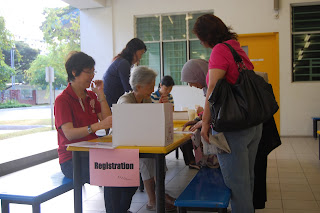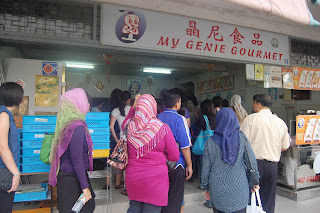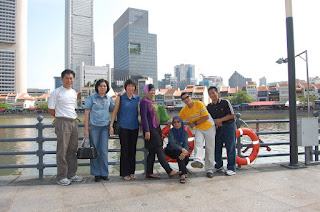As with last year, the cluster EAS LJ this year was also held on the Youth Day school holiday. Glad that I could contribute a bit to the organisation of this trip. Other than what one of the participants put "transformation from Seoul Garden to Breek Cafe" during lunch for some of us, I would say that the event went smoothly. The weather was great (Sharon had done her job) and I am sure everyone enjoyed the outing. I hope that participants had enjoyed the LJ as much as we had in bringing this to you, and also learnt something from the outing.

Arrival and registration at Geylang Methodist Sch (Sec)

A hearty breakfast to start the day

All ready and eager to go

Mdm Chua giving an opening remark before we moved out for Hougang.
In the morning, we wanted participants to see and understand how our economy had transformed over the years. We though that this could be best demonstrated by two entrepreneurs who started their business and expanded over time (My Genie soon kueh and Lee Wee and Brothers otak & nasi lemak). We were glad that both of them received and briefed us personally. We wanted to know more about their considerations and challenges in running the business, and not so much about their products. It is never easy to run a business. You have to be on your toes all the time, to ensure your raw materials are available, to ensure your labour and expertise are there, to have the outreach for sales, and more importantly, to innovate and improve or introduce new products.
My Genie is managed by Mr Lawrence Lim. Although an engineer by training, he saw the potential of this traditional snack. He knows his products well, and is as capable as the Aunties he employ to hand-made the kuehs. I would guess that hand-made means better quality control, although it is labour-intensive. However, he does not have a production capacity issue currently and could also switch to machine when the need arise. By being a halal-certified kitchen, he is able to expand his customer to include Muslims. His kuehs and curry puffs are sold at a handful outlets around the island. Customers can also make orders online. He has attracted a number of food critics and earned various awards. These serve as good publicity for him.


Lawrence with his products on the top, and the various accolades from food reviewers.

Curry puff is also their key product
A few doors away is Lee Wee and Brothers. The business is managed by Lee Wee and his two brothers (hence the name). Otak is one of their signature product, as well as nasi lemak. Very much similar to My Genie, they rely on a team of mainly aunties to hand-made the otak. With three person running the business, Lee Wee better capacity. They have a fleet of trucks splashed with their eye-catching brown logo, which I would say serve as good mobile advertisement. They also operate on the concept of a halal central kitchen serving a handful of sales outlets. For Lee Wee, there is a challenge in ensuring the availability of mackerel, the key ingredient of otak. He has to rely on fishing vessels, which in turn face uncertain of supply and dependent on weather conditions for their catch. This is stark difference from the coconut, where supply is abundant and availability certain.


Lee Wee and his otak

The otak production line
Our third stop is Mycofarm, perhaps the largest mushroom farm in Singapore. Mushrooms are grown in specially built greenhouses with temperature and humidity controlled to ensure optimal conditions for the mushroom to grow. Besides the technical know-how, the other challenge is operating cost. Power consumption is probably one of their highest cost component, as the greenhouses need to be air-con 24/7. We had the opportunity to see for ourselves how mushrooms are grown on different substrate in the different greenhouses. The vast farm needed many farmhands, and as with other industries, we see largely foreign workers. Tough to employ locals at this out of the way location.

A dog welcoming us

All ears and eyes on KK Tan as he explain lesser known facts about mushrooms. Is it a vegetable or fungi?

Cooking demonstration. Simple and quick.

Stepping into a greenhouse

The racks of mushroom substrate inside a greenhouse

Harvesting mushrooms, just pluck them off.

Budding mushrooms on substrates
In the afternoon, the intent was to see how the Singapore River had transformed from a goods discharge point to the financial district of today. We started with a visit to the Supreme Court gallery (and the UFO itself) to understand the evolution of our judiciary system.

The best way to appreciate the transformation of Singapore River is to take a cruise, which was what we did. The north bank is Clark Quay. This used to be godowns, warehouses for goods carried in by the tongkangs, that carried the goods and people from the big ships that had to anchor further out. The transformation of these into the nightlife that we know today first started with the disco called "Warehouse" more than 20 years ago. Others follow suit and with the government assistance, Clark Quay became what it is today.



The south bank is also interesting, with its combination of old and new. The old buildings along Boat Quay are now eateries and pubs. Making their 2 to 3 storey shophouses are skyscrapers. UOB Plaza used to be the tallest, but OUB Building has now taken over. This area is the Marina Financial District. Plenty of banks and other financial institutions. Perhaps it has to do with the Chinese believe that this part of the Singapore River resembles the fully belly of a carp and hence auspicious. Where the big ships used to anchor then is now the integrated resort of Marina Bay Sands. In the past, there is no wharf and cruise centre. Both passengers and goods are transferred from the big ships to land (and vice versa) via tongkangs.









There is no doubt that such a transformation needed concerted effort of both the government and investors. Was it the government that spearheaded this transformation, or some visionary investor? Did they envision this endstate, or was it the developed along the way? I am really amazed by how a whole series of disused warehouses could be transformed into the top nightspot of Singapore. I am equally amazed by the transformation of the Marina Bay area, which is all man-made (reclaimed land and sea to reservoir).
Please feel free to comment or correct. You are also free to download the photos that you like.







